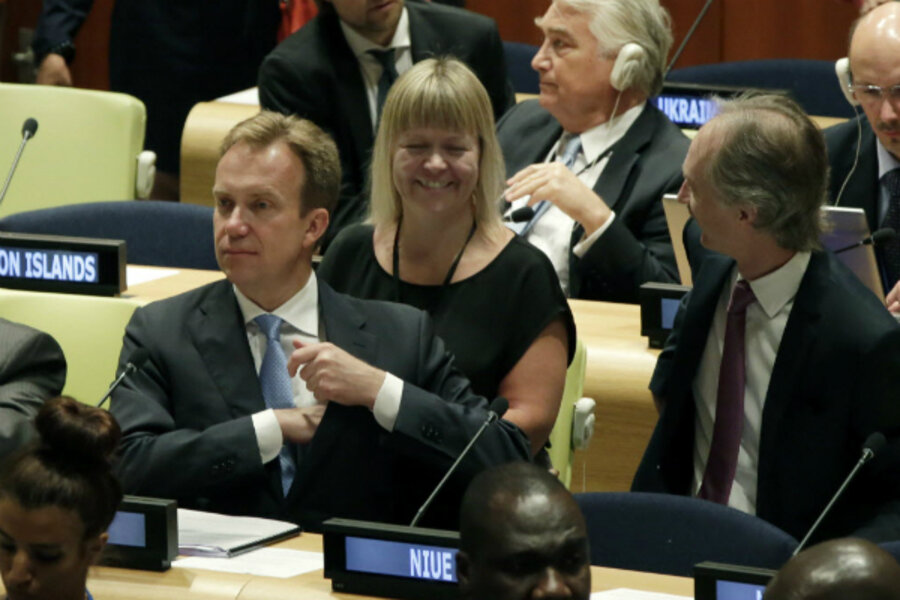UN Millennium Development goals: World cuts extreme poverty in half
Loading...
| UNITED NATIONS, N.Y.
For those who see little reason for optimism about global poverty and social trends, here’s something to cheer about: The world has made impressive progress towards meeting a set of development goals set by world leaders in 2000.
One stand-out example: The goal of cutting global extreme poverty in half by 2015 has already been met.
Want more evidence? Many developing countries have made huge strides in reducing the gap between boys and girls attending primary school. Malaria mortality has plunged by almost half. And the world managed to cut in half the number of people living without improved water sources a half-decade ahead of schedule.
That encouraging picture was painted by United Nations Secretary General Ban Ki-moon Monday as he delivered his annual report on the Millennium Development Goals, or MDGs, that the international community pledged in 2000 to reach by 2015.
Noting that the world has just over 500 days to reach the nine MDGs the UN set for itself, Mr. Ban said the goals that have already been met offer proof of the efficacy of international collective action – while new tools the world is constantly developing offer hope that more progress can be made on unmet goals.
“These achievements [on the MDGs] show that the combined action of governments, the international community, civil society and the private sector can make a difference,” Ban said in issuing what he called a “global scorecard” on the key development goals.
And while further progress by the end of next year will be “daunting,” he added that “we have many more tools at our disposal than at the turn of the Millennium: the expanding reach of technology, the deepening of partnerships, the growing understanding of how to achieve results.”
Ban’s upbeat words are not just sugar-coating on an otherwise dull bureaucratic exercise, development experts say: The progress highlighted in the MDGs annual report in real.
But they add a few notes of caution – all of which are acknowledged by UN officials.
For one thing, meeting the goal ahead of schedule of cutting extreme poverty in half was due in no small measure to the tremendous economic gains made by just two populous countries, China and India.
“Meeting that goal as a result of a huge effort in a few populous countries to reduce the numbers in absolute poverty doesn’t rule out that some countries in a few regions might actually have gone backwards,” says Farhan Haq, the secretary general’s deputy spokesman.
Another disappointment that stands out in the MDGs “scorecard” is that several of the goals that almost certainly won’t be met specifically target women and children. Declines in maternal and infant mortality are too far off the mark to meet the goals set for the end of next year, just as a goal of global universal primary education is equally unattainable.
Ban’s annual report offers evidence that the progress the world has made on many of the MDGs is lopsided when evaluated by region. In other words, despite considerable progress in some sub-Saharan African countries, many of the major strides in development since 2000 have occurred in Asia and South America.
Still, the degree of progress underscored in the report can act as a catalyst for further strides in several ways, UN officials say. Not only do countries that are lagging behind see that progress is possible, they say, but the hard statistics behind that progress help convince doubters that efforts like global goal-setting actually work.
“There’s a quantifiable impact to what’s been achieved since 2000,” says Mr. Haq. “That helps convince people that it makes sense to continue with these” goals, he adds.
Indeed, UN member countries are already working on the next such project: a set of Sustainable Development Goals, or SDGs, that the world body will adopt next year for the period 2016-2030.
One interesting aspect of the SDGs is that, unlike the MDGs, they will apply to all UN member states – rich and poor, developed and developing – alike. That means that goals on energy or climate change mitigation will pertain as much to the United States as to Mali.
Development experts say one key to setting an effective set of new goals for the world will be to build on the progress of the MDGs.
Jeffrey Sachs, a prominent development expert and special adviser to Ban on UN development goals, says for example that – instead of stopping at reducing extreme poverty by half – the world should set a goal of eliminating extreme poverty by 2030.
The world proved with the MDGs that “bold target setting” works, Mr. Sachs says. His advice to Ban and world leaders: Be ambitious, and you have a better chance of achieving the goals you set.








